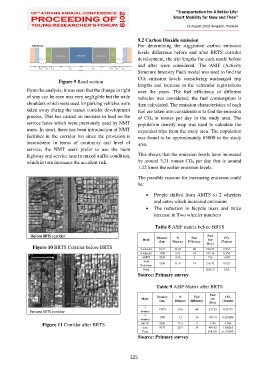Page 250 - Proceeding of Atrans Young Researcher's Forum 2019_Neat
P. 250
“Transportation for A Better Life:
Smart Mobility for Now and Then”
23 August 2019, Bangkok, Thailand
9.2 Carbon Dioxide emission
For determining the suggestive carbon emission
levels difference before and after BRTS corridor
development, the trip lengths for each mode before
and after were considered. The ASIF (Activity
Structure Intensity Fuel) model was used to find the
CO2 emission levels considering unchanged trip
Figure 9 Road section
lengths and increase in the vehicular registrations
From the analysis, it was seen that the change in right over the years. The fuel efficiency of different
of way can be seen was very negligible but the wide vehicles was considered; the fuel consumption is
shoulders which were used for parking vehicles were then calculated. The emission characteristics of each
taken away during the transit corridor development fuel are taken into consideration to find the emission
process. This has caused an increase in load on the of CO2 in tonnes per day in the study area. The
service lanes which were previously used by NMT population density map was used to calculate the
users. In short, there has been introduction of NMT expanded trips from the study area. The population
facilities in the corridor but since the provision is was found to be approximately 85000 in the study
inconsistent in terms of continuity and level of area.
service, the NMT users prefer to use the main
highway and service lane in mixed traffic condition, This shows that the emission levels have increased
which in turn increases the accident risk. by around 3.21 tonnes CO2 per day that is around
1.22 times the earlier emission levels.
The possible reasons for increasing emission could
be:
People shifted from AMTS to 2 wheelers
and autos which increased emissions
The reduction in bicycle users and twice
increase in Two wheeler numbers
Table 8 ASIF matrix before BRTS
Fuel
Distance % Fuel
Mode Use CO2
(km) Distance Efficiency (litre) (Tonnes)
Figure 10 BRTS Corridor before BRTS 2 wheeler 6375 14.05 60 106.25 0.254
4 wheeler 1500 3.31 14 107.14 0.256
AMTS 2250 4.96 3 750 1.689
Auto
Rickshaw 5250 11.57 19 276.32 0.622
Total 1239.71 2.82
Source: Primary survey
Table 9 ASIF Matrix after BRTS
Fuel
Distance % Fuel
Mode Use CO2
(km) Distance Efficiency (Tonnes)
(litre)
2 13875 30.6 60 231.25 0.55315
wheeler
4
wheeler 1500 3.3 14 107.14 0.256286
Figure 11 Corridor after BRTS BRTS 5250 11.6 3 1750 4.186
Auto 9375 20.7 19 493.42 1.180263
Total 2581.81 6.175699
Source: Primary survey
225

